This series is sponsored by:
Star & Bullock Hardware – Paper Cartridge Former Kits
https://www.cartridgekits.com
Etsy Store
This article was originally only going to be a video, but then the video came out to 40 minutes and I decided that it was worth doing a written overview for the information it contained. By all means feel free to watch the video, posted above. It will show you examples of the guns, the differences of which can be hard to explain. This series assumes that you don’t know anything about the guns that debuted in 1836 and played their last act around 1873. They were the guns that changed the world forever.
Choosing a black powder revolver, interchangeably called a pistol, is not complicated stuff. There are two predominant calibers and three to five predominant styles.
For calibers, the only two I would take seriously are the 36, which takes a .375 roundball, and the 44, which takes a .451 to .457ish roundball. Ballistically, the weight of the roundballs is the biggest hindrance to both of them being what you would consider a modern effective caliber. The 36 is about 80 grains, so think maybe a .380 auto, and the 44 is like 150 grains, so maybe a 38 Special.
When you use a conical shaped bullet, the length gives you extra weight. And this changes the whole game. As I explained in my article this past Friday on how to make paper cartridges, the bullet molds at erasgonebullets.com were what changed it. They have copied Civil War era bullets, and they got Lee to make some custom molds for them. Right now these molds are sold out, but they will be back soon, and you can buy the bullets if you are in a hurry.
With conicals, the .36 turns into a 38 Special, firing a 150 grain bullet at around 900 feet per second. The 44 turns into a 44 Special, or just north of a 45ACP, throwing a 220 grain or so bullet at upwards of 900 plus fps. There is also a 240+ grain Walker bullet, and with the larger cylindered revolvers it can clock at equal or even greater speeds. We will be covering ballistics in depth for this column in the future.
Which Model Black Powder Pistol Should I Buy?
Well right now the issue is more what you can get than what you want, but in a perfect world where cap n ball revolvers grow on trees (my perfect world anyway), there are three main types of frames in what I would call a “normal” size gun.
The 1851 Navy is probably the most prevalent out there, largely because Traditions and several others for the last few decades have flooded the market with cheap brass frame guns. They often come with a powder measure, capper and nipple wrench for $250ish. I don’t know if you will find one right now at all, let alone for that price.
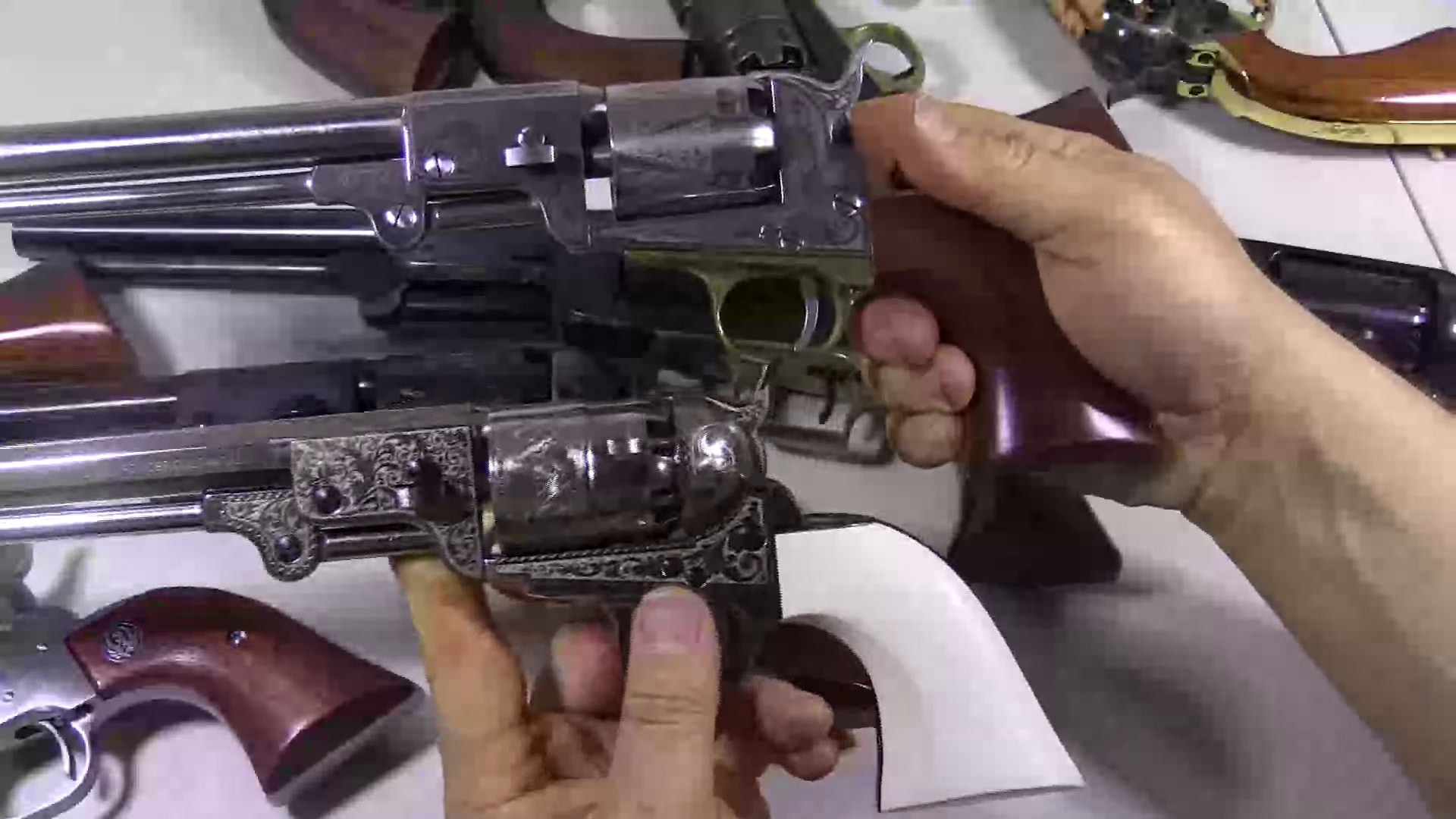
Originally the ’51 Navy came only in 36, but the Italian gunmakers have long produced the pistols in both calibers, in both brass and steel frames. In all of these guns you will find further bastardization of history for the sake of a cool looking gun, but Sam Colt was something of a sales whore himself, and originals turn up all the time in oddball configurations that don’t make sense.
The most popular black powder pistol is probably the 1860 Army. It has smooth lines, and the grip fits even three big fat fingers like mine. Mostly you will find this gun in 44, but there is a Colt 1862 Police that is visually the same gun, in 36.
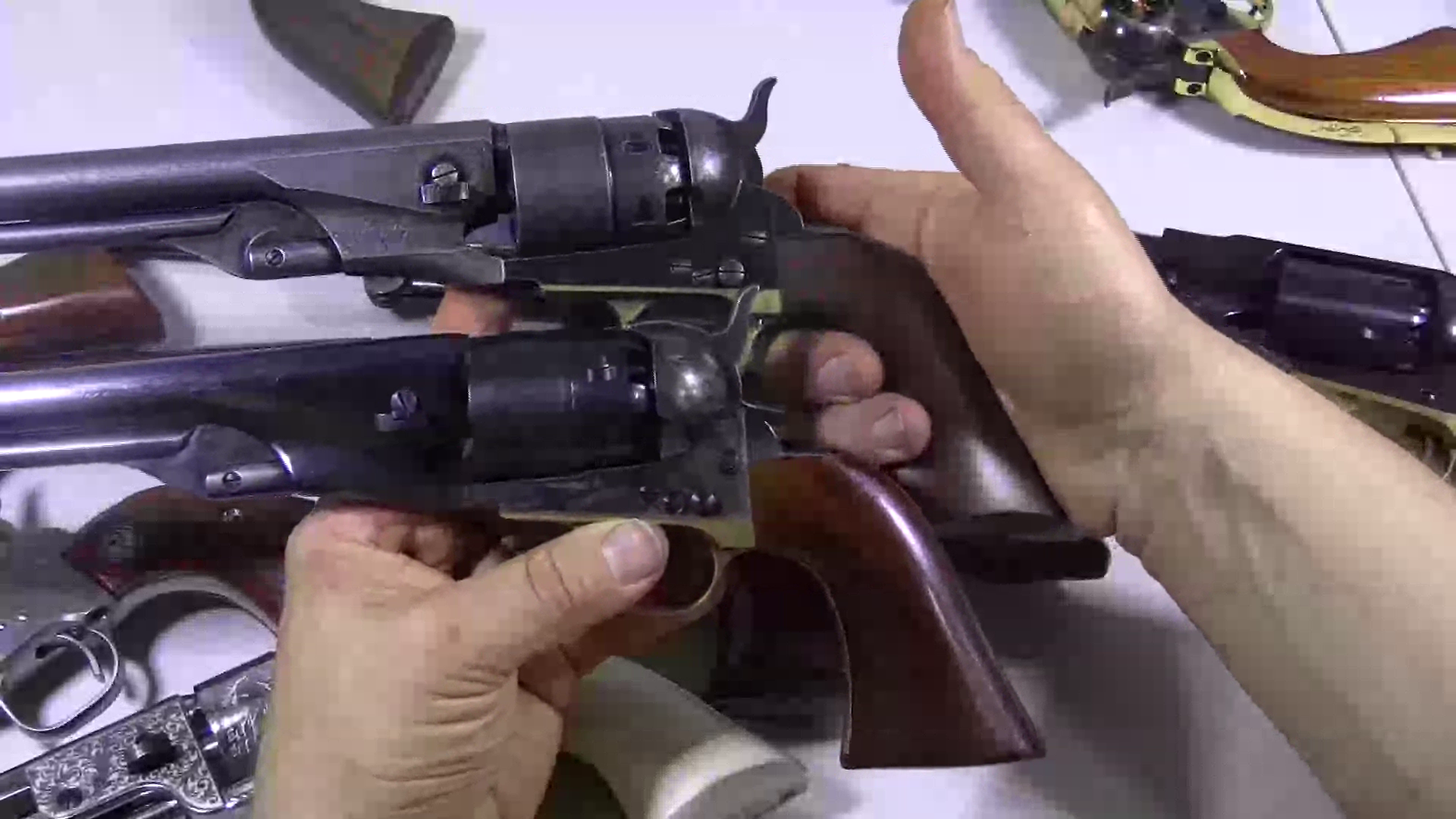
One thing you should note if you are in the market for Colts, is that the ’51 Navy does not fit the Johnson & Dow bullet unless you tap it in before it gets to the port in the cylinder for the loading lever to compress it. The ’60 Army fits it fine, regardless of who made the gun, or when it was made.
Now I’ll jump to the 1858 Remington, which I almost forgot in the video. This gun visually looks entirely different from the Colts. It has a top strap, like a modern revolver. This aspect changes the whole dynamic of the gun, and it makes it the most desirable of the cap & ball pistols for a battle, for daily carry, or wherever you are most likely to get in an actual gunfight.
The reason is that the cylinder can be swapped out easily, allowing you to carry what are effectively “extra mags” or speedloaders for your Civil War era revolver. Now I’m not going to get into a discussion of whether it is “safe” to carry a capped cylinder, but there are leather belt pouches made specifically for them, which you’ll find on Etsy, and Midway actually carries one as well.
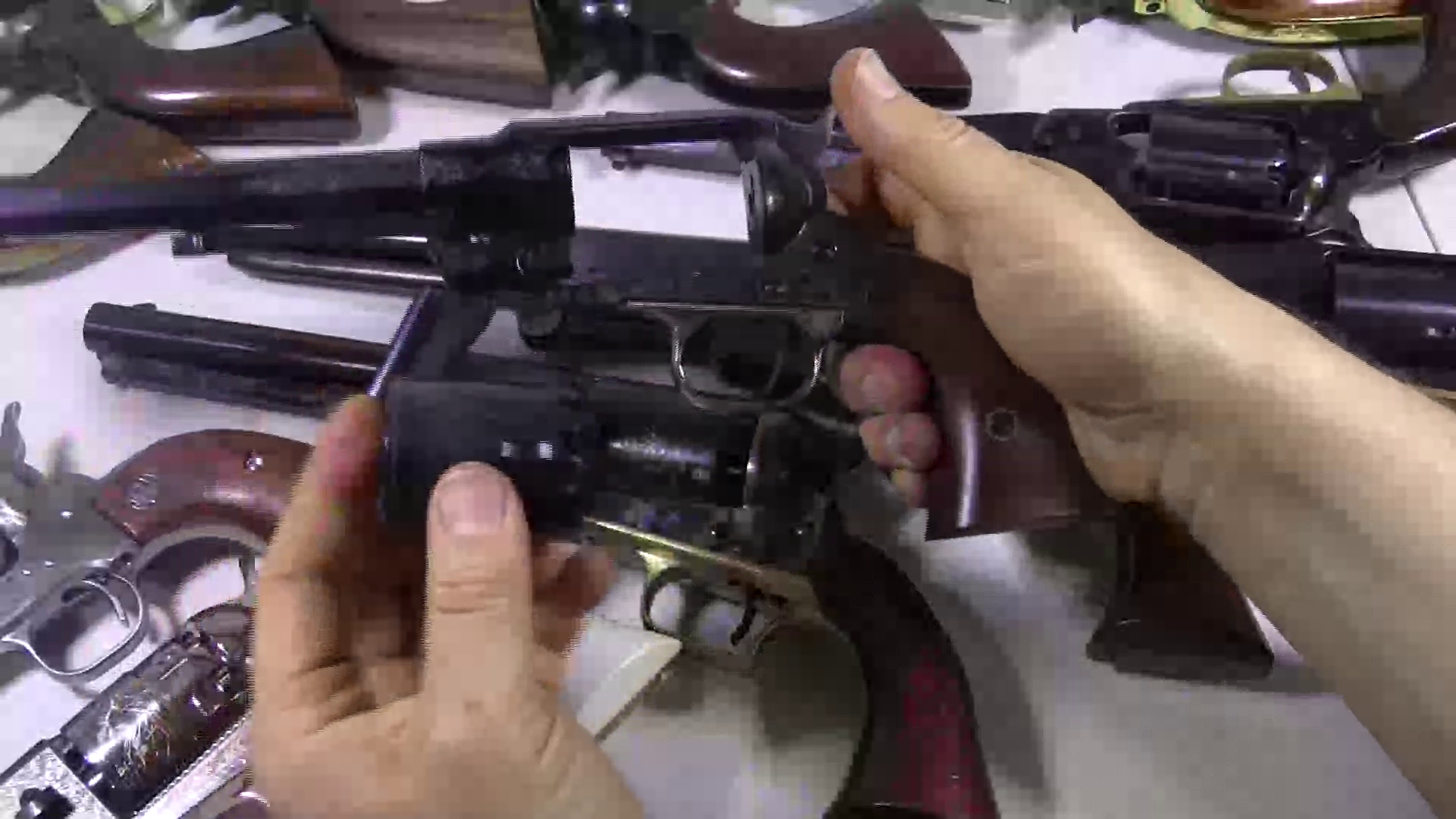
To swap out a cylinder on one of the Colts, you have to pull the barrel wedge, then use the rammer to pop the barrel off of the frame, then put it all back together. There is a pesky little screw that I always figure out a way to drop, and I don’t think anyone would argue that this is something you want to be doing in the middle of a gunfight. The ’58 Remington is super easy. You drop the loading lever, push the cylinder pin out, and pop the cylinder into your hand. Inserting a new one is just as easy.
Now I’ll move to the large guns, which are also Colts. The Colt Walker was Sam Colt’s second gun. Whereas the first one, the Paterson, is slim, light, and 36 caliber, the Walker is a monster. It is the original horse pistol, and I don’t think a production revolver has been made larger since. Made in 1847, the cylinder of the Walker is a great dealer larger than a standard 44, so it holds more powder, and from that you get ore velocity, exceeding 1,000 feet per second with the 240 grain Eras Gone Walker bullet.
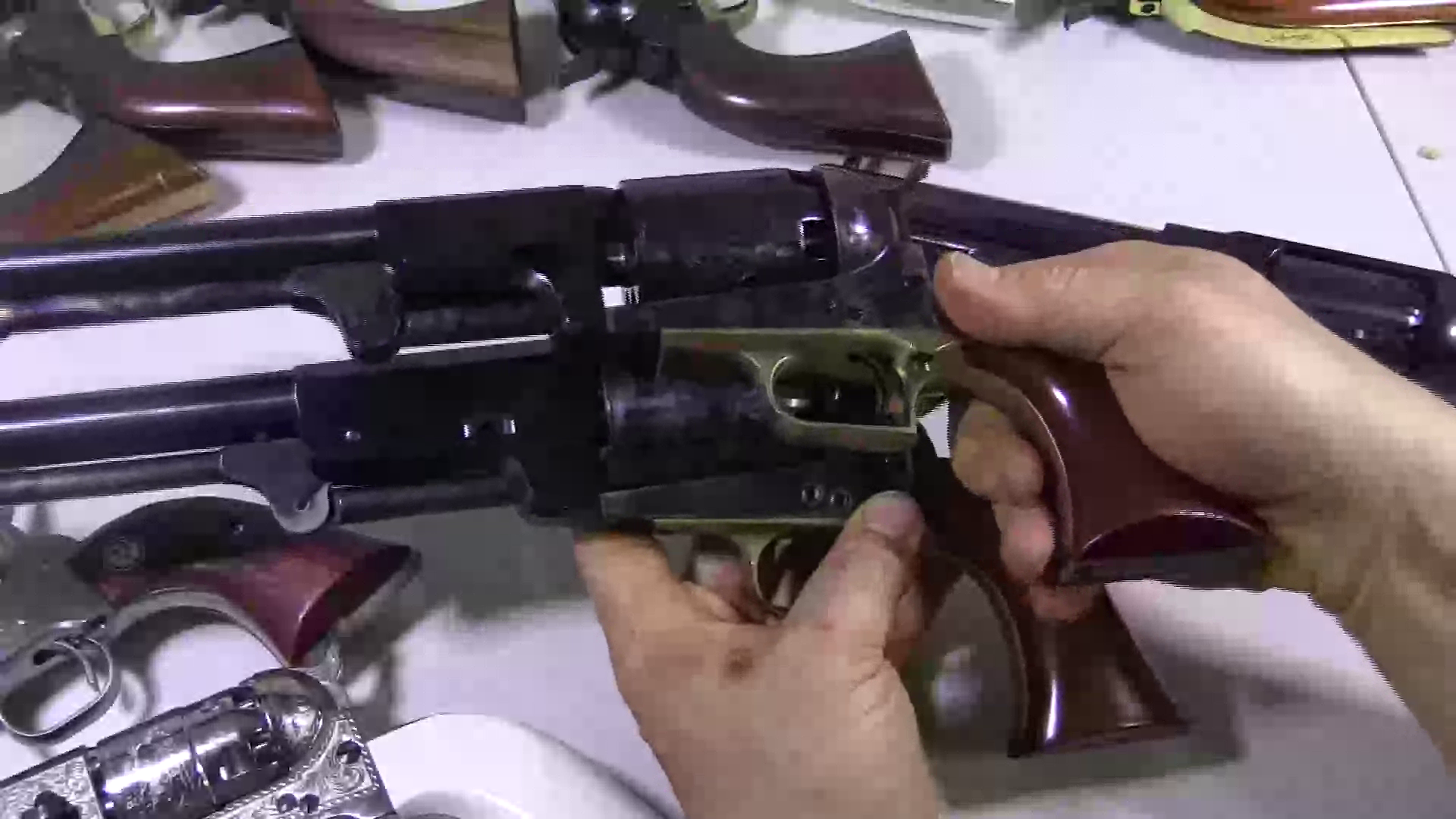
The Colt Dragoon is kind of a half way. There are a few different models, not much different from each other really. They all have a cylinder smaller than the Walker and larger than the ’60 Army. And they all have the same normal size barrel length. It’s a bigger gun, fits a bigger hand, and probably does not lose much velocity compared to the Walker, in a much more manageable package. The Dragoons also have a clip at the front of the loading lever, whereas Walkers do not, and those Walker levers tend to be a problem.
I’m not going to cover the 31 caliber guns right now, because without conicals they just aren’t worth the effort, and the conical molds are not available right now or in the near future.
So I will finish this section with the Ruger Old Army. This was a gun that Ruger came out with decades ago that was based on their Blackhawk frame, but has a loading lever, so is not not a Blackhawk and does not accept Blackhawk cylinders. Unfortunately some gun dealers transfer these cap & ball pistols through a form 4473, but they are not an FFL gun according to any interpretation of Federal law to my knowledge. Ruger stopped making the guns because a cartridge converter became available for it, and that is still available today, as well as for the ’58 Remington.
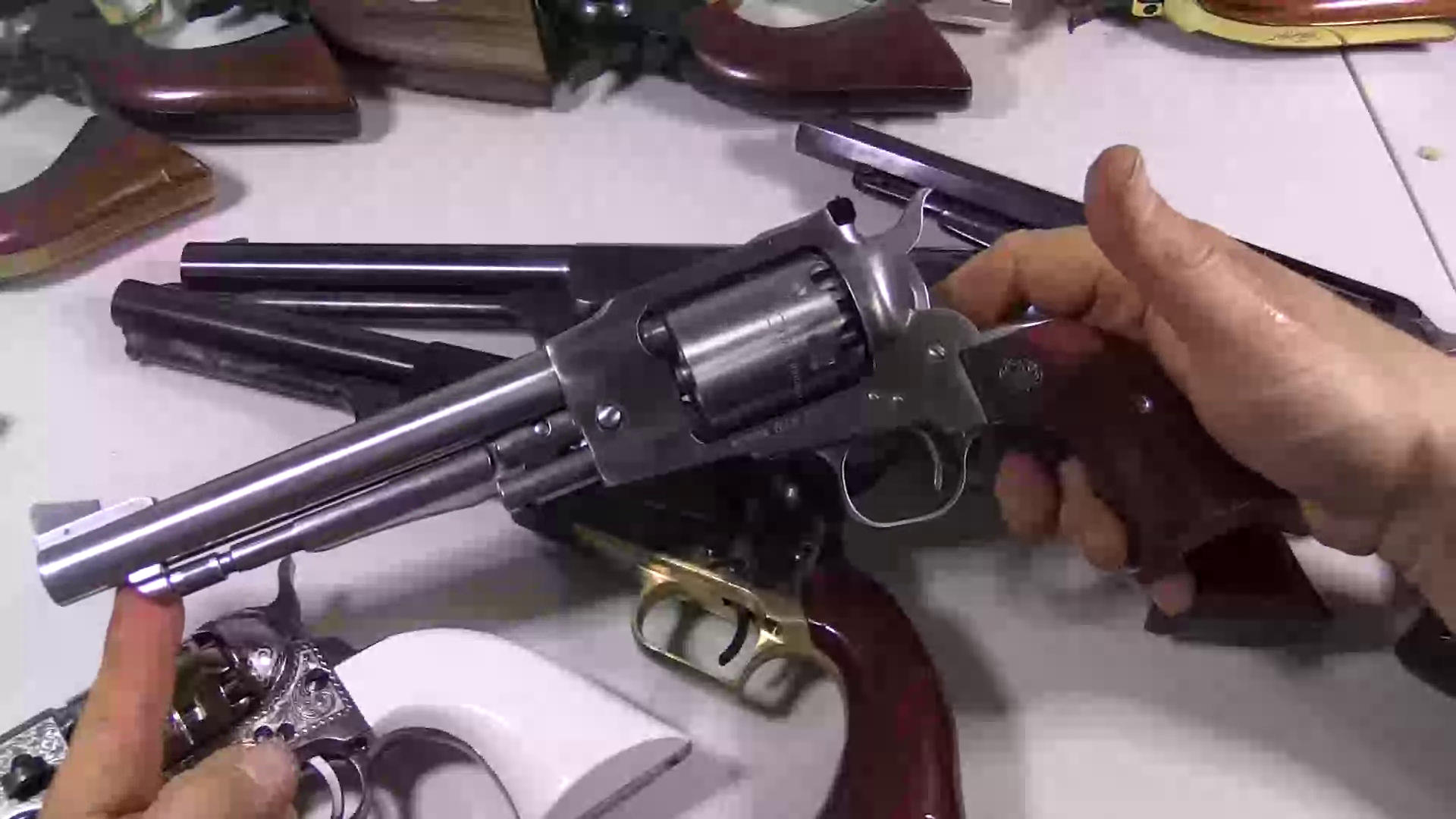
The famous story of the Ruger Old Army is that the engineers at Ruger filled the cylinders on the prototype with Unique, and a ball. Now, Unique is a very fast pistol powder that is famous for boneheads blowing up their guns with it by overloading them and not following the load data. So they used it to try to break the ROA. It held up.
These days, most of the ROAs are getting a little tired if they have had significant use, but you can still find them in unused condition, at a premium price. Functionally there is zero advantage to the ROA over an Italian ’58 Remington, at more than twice the price. There are no parts available for the ROA, and extra cylinders are almost as much as the gun when you can even find them. The loading lever comes out in pieces when you swap the cylinders, and you need a screwdriver to swap them.
I personally hate the gun, and even though I own a few, never have used them for SASS or any other regular shooting. My advice is to buy two stainless Piettas for the same price, and see if you can get them sequential!
Manufacturers
Most of the guns in the market today are made by Pietta. There are some, like the Walkers and the Dragoons, that are made what seems to be exclusively by Uberti. Uberti makes the other guns, but you don’t see them right now very often in the market. I think they decided to go more towards the cartridge gun market.
There is no functional difference between the two. It used to be that Uberti guns were just nicer, but both of them are nice now. They also seem to work as reliably. These are handmade guns, so you are going to occasionally get a Friday afternoon gun or a Monday morning gun, but in general they are reliable and extremely robust.
That may not always go for older used guns. There are specific manufacturers, like Armi San Marco, that made some good guns, and a lot of bad guns. And even though these guns have moving parts you can count on one hand, the current parts don’t always fit the old ones. An older Uberti is always going to be a good bet, but other than that you should be able to test the gun before purchasing.
If you want a “real” Colt, the first generation originals are at a premium right now as everyone expects the dollar to collapse on the historical garbage heap of fiat currencies, but you can find them. Under a few thousand bucks they tend to be very rattley. `It’s all about your budget.
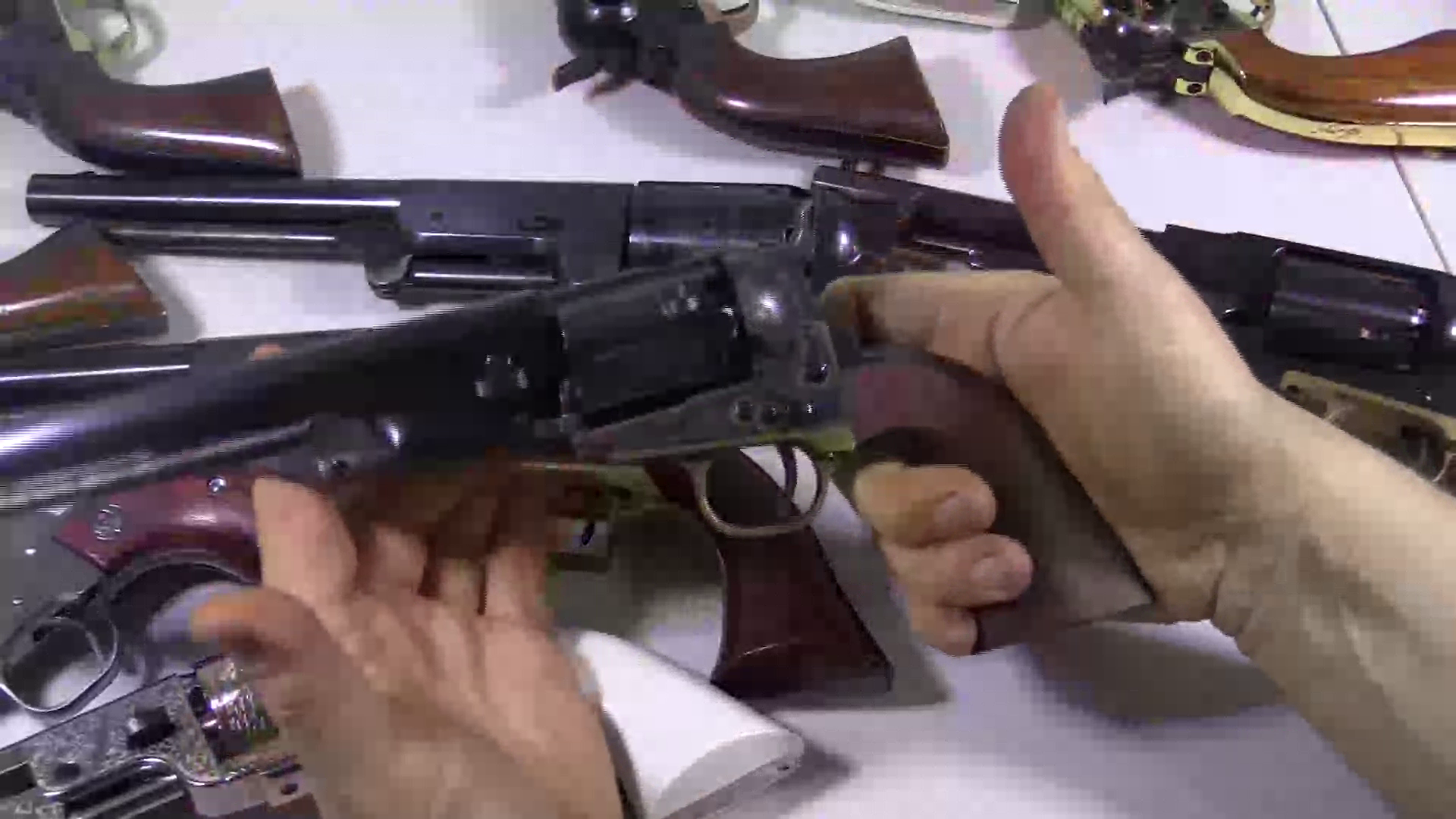
For the second generation guns, I would not count on buying one as an investment, but they do work great, and they say New York on them, not Italy. Where the guns were actually made is dubious, and from what I have read, Colt claims that a disgruntled office worker made off with all of the records. I personally doubt that those parts were made in the US, even though I do own a couple of them.
Colt admitted that the third generation guns were at least partially made with Italian parts. I think Uberti made them 100%, and I have not found evidence to the contrary. They are indistinguishable from an Uberti, except that they do say New York.
Caveat emptor takes on a whole new meaning when it comes to historical Colts because a major appraiser was arrested and jailed for counterfeiting guns. His name is R.L. Wilson, and his name is on many of the historical books that experts use to establish the provenance on what are called legitimate guns. Look him up. Thousands of historical guns passed through his hands. That was just one guy who got caught. All of the original letter and roll engravers have been offered at auction at some point, and Italy makes great copies to convert into fakes. You judge if a historical Colt is a good idea or a solid investment.
Brass vs. Steel Frames
As I explained in the video, I personally have never had any issues with my brass frame guns, and many of them have seen a ton of use shooting SASS. I shot almost every weekend in the New England area during the 90s (I am SASS#19811), and have even traveled to New Mexico for End of the Trail. All that time I shot either straight brass frame guns, or nickle plated brass frame guns, and I have never had a gun break, warp, or even get loose.
The internet experts would beg to differ, and unfortunately, online, you have no idea if someone is lying about their actual experience. I had a discussion on a black powder forum recently with a group of guys who claimed that they use a cylinder loading contraption, because the pressure of the loading lever on the cylinder bends the pin in the frame.
I say horseshite. But I’m like that.
Historically, Colt never made a brass gun. In the South there were factories that made Colt copies out of brass, and that is why you will usually see them called “Reb” when they have a name on them.
So I do ask myself, if brass really isn’t inferior as I suspect, in these low pressure guns that have steel cylinders, why didn’t Colt make them? Brass is cheaper and easier to work than steel. Maybe he just didn’t want to fix what wasn’t broke, or maybe they did some tests and the brass didn’t hold up as well. It will remain a question for history.
Buy the gun you can afford, or that you love. Some of the prettiest engraved guns are nickel plated brass frame. And even in the steel guns, there are some with a case colored cylinder, some with a black blue, and Cimmaron even offers guns in what they call a charcoal blue that looks like the guns did back in the day.
One finish I will warn you away from is Pietta’s “Old West” finish, that is meant to look like a rough condition historical Colt. It looks like sparkle glitter to me, and I think you will be as disappointed as I was.
Where to Buy Cap & Ball Black Powder Revolvers
I would love to say hey just buy them on GunsAmerica, but we don’t get a lot of them. I have found some nice scores here, most recently on a gold plated and engraved Patterson. But because the guns are not FFL, and not collectible, I think people just don’t think to list them here. You can use the search for pietta or uberti and sometimes you’ll nail something not available in the market right now.
Right now a couple places have guns in stock, and others are taking back orders.
Dixie Gun Works probably has the most in stock. They don’t take back orders, and you can’t even list their inventory by in stock vs. not in stock, so it’s cludgy, but in today’s lazy world, the busy bird gets the worm. Dixie has a lot of guns in stock right now that nobody else has had in stock for months. They take about a month to ship, and Dixie is never the best price, but you’ll get them.
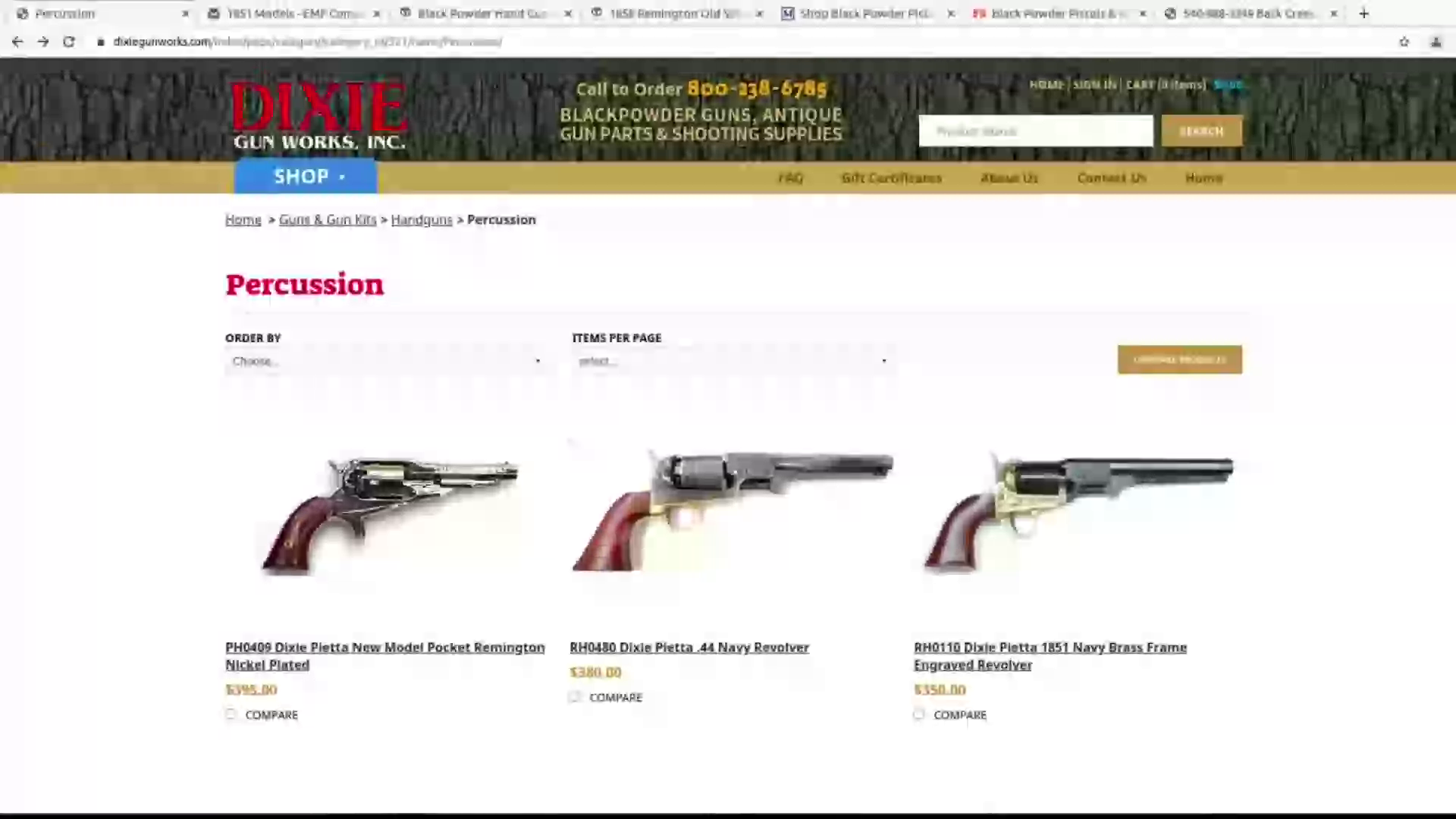
Midway USA has some Walkers and Dragoons in stock as I write this, at GREAT prices, and they let you place backorders for many more. Midway ships the next day usually, and you get them a few days later. In my experience Midway will not take a backorder for something that just isn’t coming anytime soon. So if they let you backorder it, most likely the shipment is already on the way in, and you’ll get it shortly.
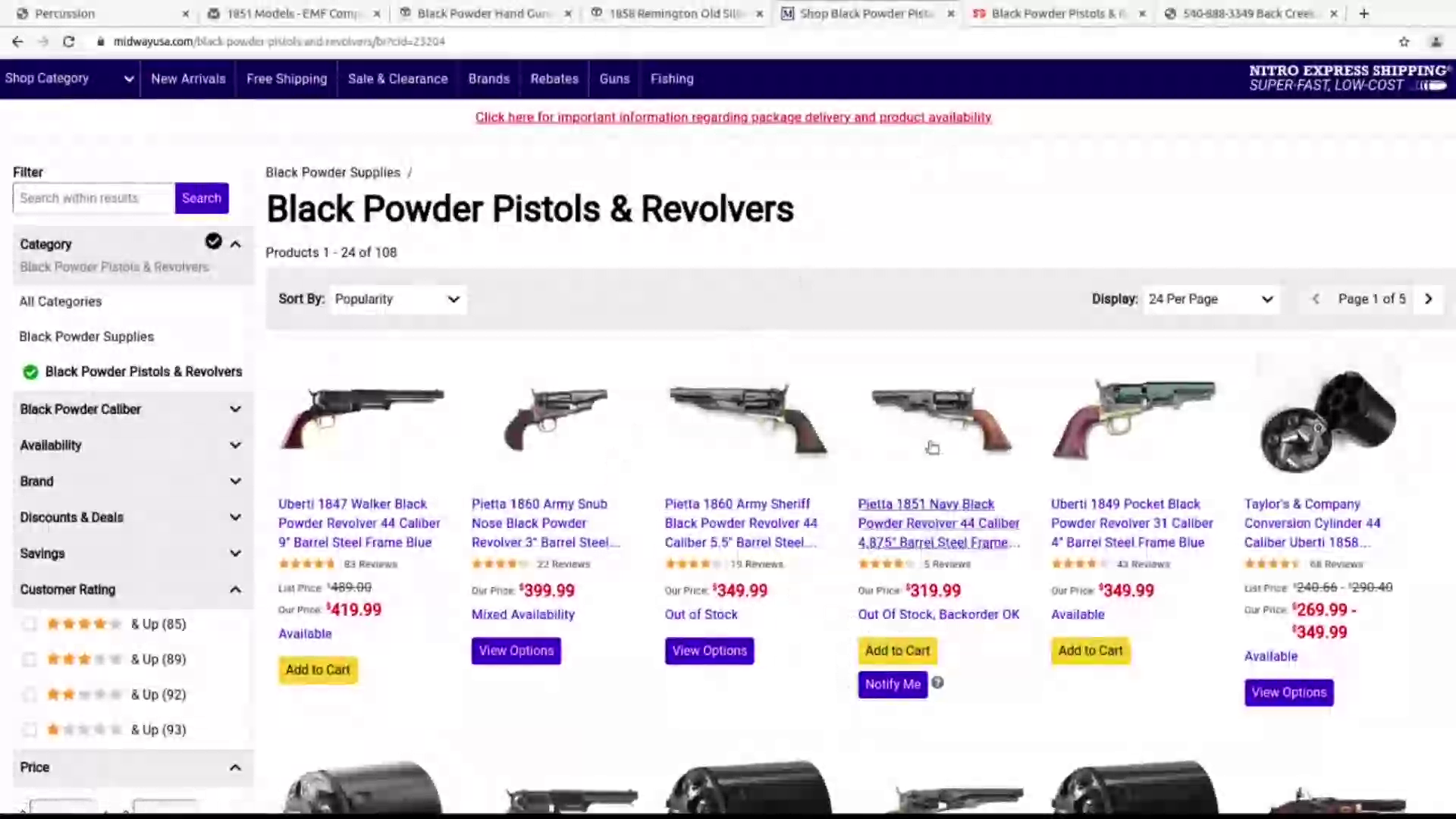
For those inexpensive Traditions kits (also Pietta guns actually), check out your local Bass Pro or Cabelas. They are standard in stock items, and the big box stores get priority in many things. Cabelas used to be a wealth of black powder pistols. I bought my engraved nickel plated guns there in the 80s I think, for like cheap. But these days they aren’t selling any of these guns online.
The best place for backorders is EMF. They are the largest importer of Piettas, and they bring in a lot of really pretty guns that nobody else has ever. As I showed in the video, I’m not nuts about some of the laser engraved guns I got from them, but they are still pretty. And there are plenty of guns with shallow and even deep engraving.
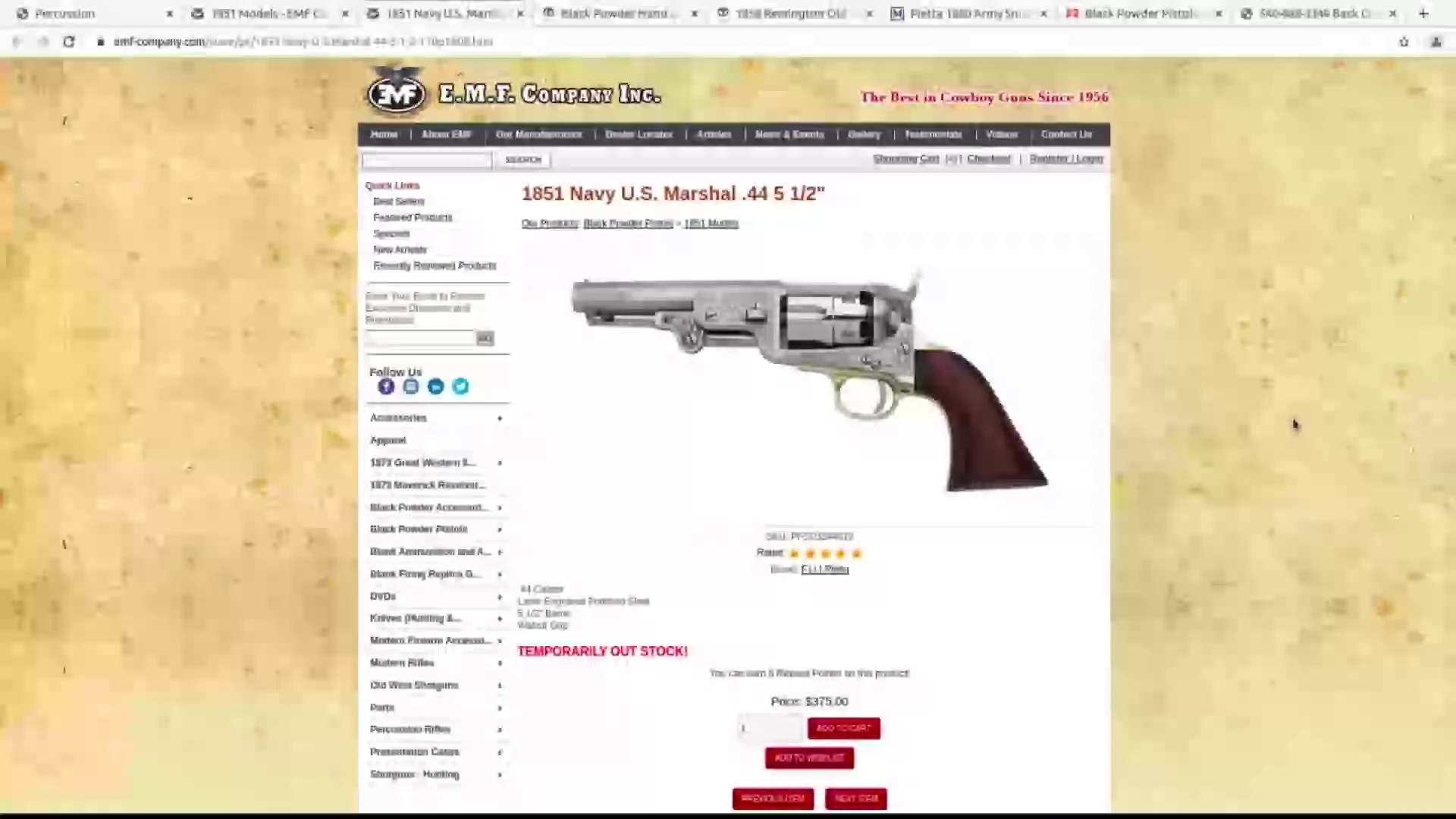
Don’t worry about losing your money with EMF, because you paid and the gun doesn’t come in for a year. They do not ding your card until it comes in, and they call you first before they run it to let you know that the guns have arrived. It also gives you the opportunity to ask for a consecutive pair if you are getting two of the same. They are a great company and bring us some great guns.
Taylors & Co. works exactly the same way. They allow you to check out on out of stock things, and like EMF, they will call you to let you know it is out of stock, and they will call you to let you know when it arrives. They also have some really pretty exclusives.
Sportsman’s Guide is my final suggestion, because the prices are really good. They only carry a handful of guns, including a couple brass framed guns that are tastefully engraved. But the delivery dates have been stretching further and further away. Right now a couple guns are still promised for June, but I did have my order for the revolving rifle they sell moved up a month already.
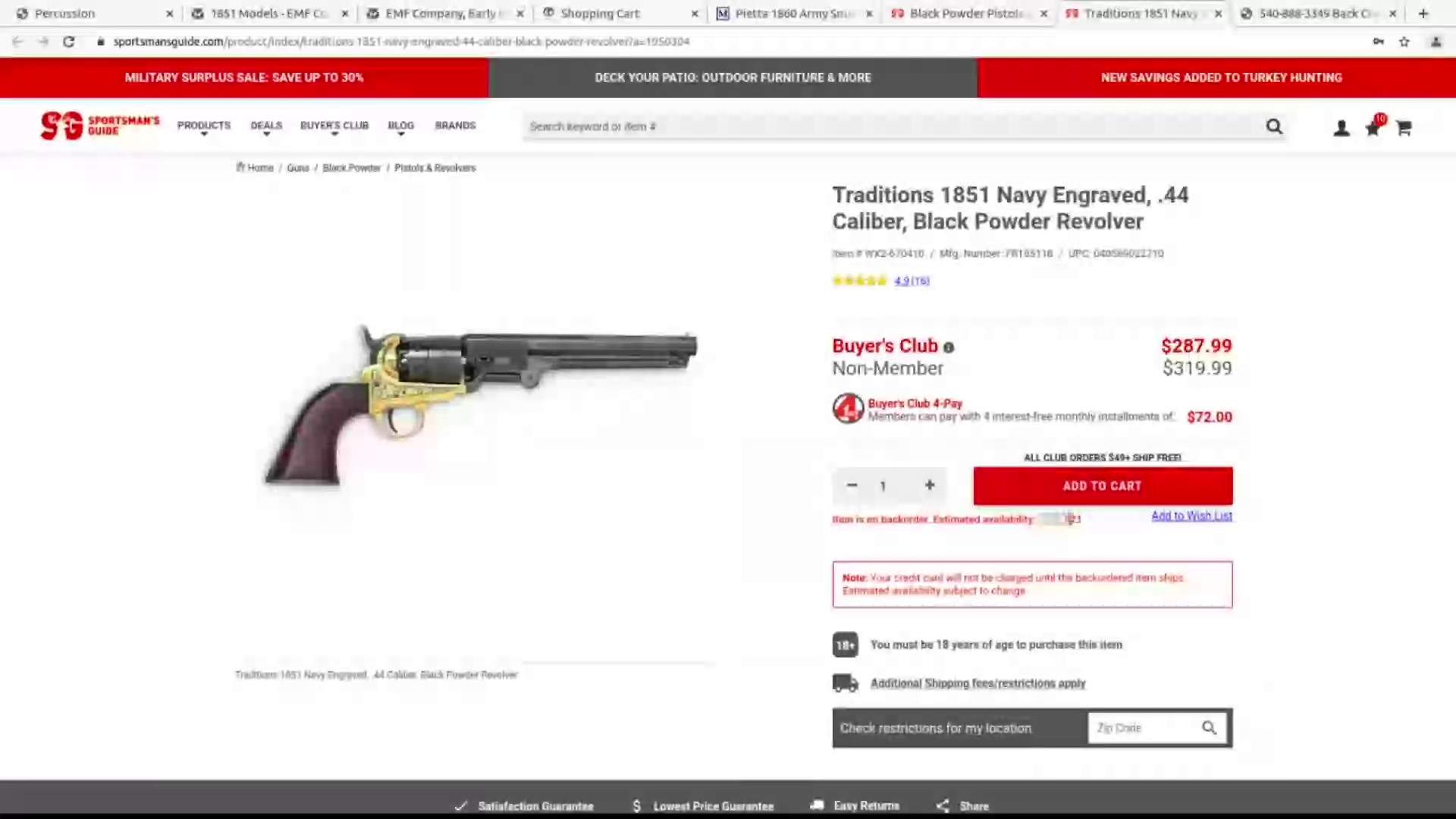
I would not suggest ordering directly from Cimarron. They cancelled my order as soon as I placed it. You’ll get all excited that you scored, for a big waste of time as I did.
Why Buy Cap & Ball Black Powder Pistols
This is a difficult subject, because I don’t want to sound like I am suggesting that you go behind the government’s back, but hey, the law is the law, and it is the law the way it is for a reason.
In this Republic our right to Keep and Bear Arms is absolute, except that it isn’t. As a society, limits to that right have crept in using the excuse of public safety. You can’t have a machinegun, because you might get pissed at your brother in law at a family event and spray all the innocents who you didn’t mean to shoot.
Well some of it kind of makes a little sense. But when you talk about these percussion pistols not requiring an FFL, you are talking about the National Firearms Act of 1969. That was when guns went from being able to be sold anywhere, to guns being only sold by licensed gun dealers.
Black powder revolvers do not fall under this law, and were intentionally written out, because crimes have not historically been committed with antique guns or replicas of antique guns. That’s it. There was no public safety angle, so they were left out. I would venture to say that not one person who ever reads this article has ever or will commit a violent crime, PERIOD.
So to extrapolate that, it was not because black powder guns were not as effective as cartridge guns. They are every bit as accurate, reliable, and deadly as any other gun in their ballistic range. That range, as I explained above, does vary by what type of projectile you are shooting, but hey, a ton of people carry a .380, not to mention a 25ACP! I just saw a video the other day of a guy dinging a gong at 1,200 yards with a muzzleloader. And these black powder pistols are not to be trifled with as well.
Throughout the ages, over 5,000 years of civilization, guns are a fairly new arrival. Yes they have progressed quite far since firearms started to become widespread, but prior to that, you could have ruled a village with one of these guns. And with an small army of them, you could rule a nation. Swords, spears and arrows were just no match.
Who wins a gunfight usually means whose gun gets on target first. How many rounds your magazine holds, or if you have to cock the hammer for shot #2 is rarely a factor. There will be a cloud a smoke with these guns, but when that smoke clears, these guns have every bit as much firepower to make sure that gunfight is over as any other pistol or revolver.
There is an old saying, G-d made man, but Sam Colt made them equal. Prior to guns, a big man could always control a small man, let alone a woman. Guns put everyone on the same level. A 100 pound woman can take down a 300 pound 6′ 5″ man with a 36 caliber Colt Paterson, and she can hunt her own meat with a Walker. These are the guns that changed the wold forever, and they are no less potent today.
So yea, there is a side benefit that when they finally do come for the guns, that nobody knows about one you have. The intent of our 2nd Amendment was not about stopping a home invasion. It was a defense against tyranny, that is now right on our doorstop.
Note that the end of the video has some places to get powder and caps. You local dealer may be able to help you with both. I strongly suggest Hodgdon Triple Se7en for new black powder shooters. It will not fill your cylinder gap with crud, and cleaning it is very easy with soapy water. It also doesn’t stink as bad as Pyrdodex, and Midway had some last week.
